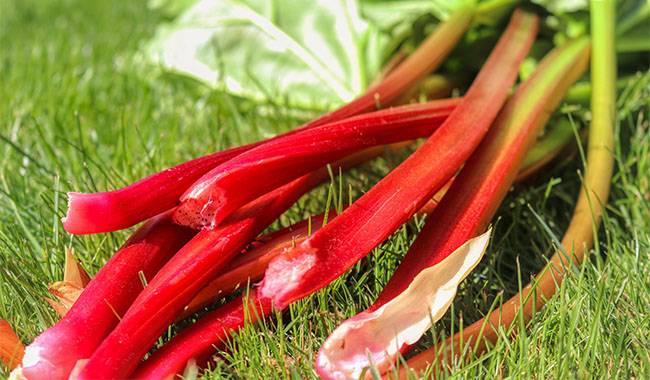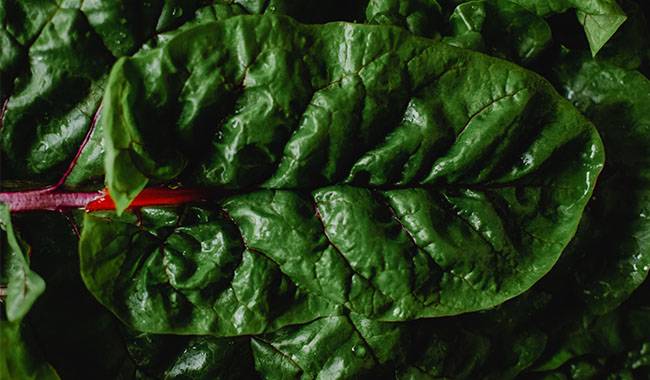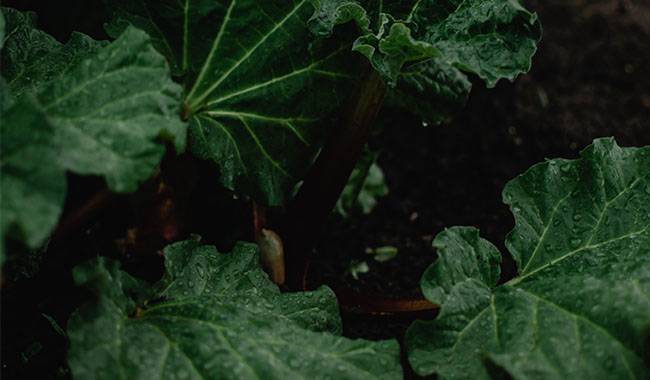
It’s impossible not to admire giant plants – you can feel the power and vitality all at once. Although our small plots are not suitable for giant plants, many people want to grow such things. We also have Rhubarb at the edge of the woods (our small plot borders the woodland), with 8 feet (2.4 m) tall foliage growing on thin gray woodland soil, 2 feet (60 cm) in diameter. Power! On the property, understandably, it also sprouted. The huge lobster-like leaves have to be cut down after admiring them. Incidentally, the locals acidify the young leaf petioles, which taste great. But Rhubarb is a topic that threatens administrative penalties in many places, so it’s best to enjoy other burdock plants like Rhubarb. and it has something that will surprise you!
This ThumbGarden article looks at Rhubarb – familiar and unfamiliar varieties, their ornamental qualities, and what delicious things we make with Rhubarb.
Rhubarb is Familiar
In North America, Rhubarb is commonly used to make cakes, pies, towers, cookies, sauces, Rhubarb jam, etc. It is very popular in North America along with strawberries to make pies; however, many people like to eat it as a fruit or make salads, but Rhubarb is actually in the vegetable category. Rhubarb in the Toronto market is the purple or red leaf stalk of Rhubarb, which has a heavy acidic taste (some describe the taste as very tough) and requires a lot of sugar to be added when cooking. With small slices dipped in sugar and eaten raw, the taste is still acceptable. While the green or yellow leaves are not edible, raw leaves are poisonous.
However, there are 2 main categories: Hothouse and Field-Grown. Hothouse rhubarb has pink to light red roots and yellow-green leaves, while Field-grown plants, which taste heavier, are cherry red in color and have green leaves. When fresh Rhubarb is bought, it should not be left for too long, up to 3 days, and it should be wrapped in plastic wrap and kept in the refrigerator. With time, it will turn black.
Despite its general lobster-like appearance, it is completely unrelated to burdock and wattle. As soon as it flowers, it is immediately clear. Rhubarb (Rheum) is considered by botanists to belong to the buckwheat family and is a friend, comrade, and brother of buckwheat, mountaineer, and sumac. Of course, botanists know best.
In nature, it grows mainly in temperate and subtropical regions of Asia, tending to mountainous landscapes. On mountain slopes and meadows, these monumental plants are exceptionally outstanding with their huge, sculpted, wavy, and even clumped leaves and tall skeletonized inflorescences.
Garden rhubarb (Rheum rhabarbarum) is common in gardens.
It is an unpretentious, winter-hardy plant that has long been introduced as a vegetable. Incidentally, in the United States, it is considered a fruit. Botany has nothing to do with it, it is purely a matter of economics.
Therefore, Rhubarb is common in gardens in the coldest parts of the country, although it can be grown in the southernmost zone 7.
This Rhubarb has large, triangular leaves with rounded margins and green or reddish petioles, which are vegetables (or fruits) when young (petioles).
Rheum palmatum, Rheum Officinale, and Rheum tanguticum, now considered a subspecies of a finger, is grown as a medicinal plant and can therefore be sold under any of these names. Or even two at a time.
Rhubarb has large leaves, up to 30 inches in diameter (76 cm long), with 5 or 7 lobes. The lobes are pointed. Flowering stems can be up to 10 feet (3 meters) long. The young petioles are edible, but it is grown primarily for the rhizomes, which are used medicinally. The leaves of Tangouta are more deeply indented and used for the same purpose. rhubarb features largely rounded or broadly ovate leaves – up to 20 inches (50 cm) long – on edible stems. The harvested rhizomes are used for medicinal purposes.
The only known European species – Rheum rhaponticum
Leaves are heart-shaped, up to 20 inches (50 cm), and slightly wavy. The flowering stems are up to 60 inches (1.5 m) tall with small, creamy white flowers. The petioles are edible. The roots are not as valuable for medicinal purposes as previous species. This particular species has long been involved in hybridization, and its “blood” is present in many cultivars.
Vegetable Rhubarb already has a considerable number of varieties. I won’t expand on this issue, there is a good article on the site with details on varieties, cultivation, and harvesting.

Rhubarb is Strange
There are also Rhubarb species that do not grow naturally in mountain meadows, but in certain alpine areas where they are quite dry. Adapted to dry climates and sudden changes in temperature, they differ from their meadow counterparts by having rippled ribbed leaf surfaces with deep veins through which the collected water flows to the rhizome.
Rheum maximowiczii has large, 20×24 inches (50×60 cm), young, strongly grooved leaves and older, smooth leaves with edible petioles. The leaves have spiny edges. Grows in very dry conditions in some mountain ranges and in the Tien Shan. The flowers are green and fruit with beautiful orange-red winglets.
Rheum ribes is also known as Syrian or warty. It has reddish warty leaves and warty stems. The petioles are edible and the roots are used as medicine. The stem with the red winged fruit looks like a berry bush.
Rheum tataricum is widespread in Kazakhstan. A truly ephemeral plant: in spring, two to three 20 inches (0.5 m) long round, spotted leaves are spread on the ground and inflorescences appear later. By the beginning of the dry heat period, everything is dry and the seeds are carried away by the wind – it is empty. The steppes of northern Kazakhstan are quite harsh both in winter and summer. Therefore, the plant is quite resilient in the dry, sharp continental climate. It is listed in the Red Book and protected.
In the Himalayas, at an altitude of 2.5-2.8 miles (4-4.5 km) above sea level, a very unusual species of Rhubarb grows, the noble Rhubarb (Rheum nobile).
During flowering it looks like a conical tower with a broad base of green folded leaves, followed by a long creamy cone of translucent, overlapping bracted leaves and a pink tip. It’s a fairy tale! Especially in the Himalayas, against a bare rocky backdrop. This is how the plant has adapted to protect its flowers from temperature fluctuations and high UV radiation at high altitudes.
Similar flowering stem characteristics of Rhubarb Alexandra
It is sold under the name “Alexandra Rhubarb”. This species has lance-shaped leaves and a long inflorescence with loosely arranged bracteate leaves. It is sometimes sold as ‘Noble Rhubarb’, but the spear-like leaves in the description or photos make it easily identifiable.
Rhubarb Decorative Uses

The most common decorative feature is the rosette of rooted leaves, which can be as large as 60-80 inches (1.5-2 m) in diameter. But Rhubarb is also incredibly attractive with its unopened inflorescences and fluffy clusters of small green, white, cream, or pink flowers, and its ripe fruit with small red, orange, crimson or brown wings. The flowering and fruiting plants look monumental, even self-sufficient. That is why Rhubarb makes such an impression in the mountains, where only stones and grass form the background.
All described partial Rhubarb varieties can grow and overwinter in dry areas in the central region and in the south. Wavy, palmate, Tangutta, and Black Sea Rhubarb, as well as their hybrids, will do well in the mid-mountain. Ornamental, brightly colored species need more sun. Alpine and steppe species (from the raspberry section) usually prefer open spaces.
The monumental appearance of these plants requires some distance, so they belong in the background of a flower bed or along a fence. Against a monochromatic background, the delicacy of panicles is most rewarding to see. And in general, it is not easy to include them in floral combinations – they tend to play solo. If they do not bloom, but concentrate on foliage, then Rhubarb bushes can serve as a good background for large-flowered plants and small skeletonized plants. If the size of the lawn allows, a decorative Rhubarb bush with a 60 inches (1.5 m) long clump of green roots and leaves and an 80 inches (2 m) long inflorescence is very pretty!
For this purpose, finger-like Rhubarb varieties such as the young red leaves of ‘Bowles’s Crimson’ are suitable. In summer, the red hue is retained on the back of the leaves. “The shoots and leaves of ‘Atrosanguineus‘ are a deep reddish-purple, but as the plant ages, the tops of the large, sculpted leaves turn green. The flowers are deep pink.
Rote Auslese comes in white, pink, and dark red flower forms. young leaves of the Rote Auslese variety are reddish-bronze in color, and over time, the top leaves turn green, the bottom leaves turn purple, and in the fall the leaves turn completely red. The flowers are burgundy.
Russian Rhubarb varieties would also look good there: their spreading, corrugated and clumped leaves add a touch of surrealism to the landscape. Rhubarb and Alexandra look absolutely alien, especially when surrounded by gravel and rocks. Unfortunately, the flowering period is short and there is no fruiting beauty; the stems will have to be cut back.
The small Rhubarb is very good for stony gardens. It is their native environment, where they are comfortable, and they will show their best qualities exactly in a rocky environment. However, they can also be incorporated into flower beds: for example, they would also be quite suitable for contrasting with the carved openwork foliage of geraniums.
What We Do with Rhubarb
When Rhubarb really gets big and starts to encroach on its neighbors’ territory, it’s time to use the petioles for cooking. It doesn’t matter if it’s an ornamental Rhubarb or a vegetable Rhubarb. Of course, vegetable Rhubarb has more “marketable” petioles – long, thick, smooth, and with less crude fiber – but all other petioles are also edible.
Rhubarb sauce is a classic, and we used Rhubarb sauce with honeysuckle, garden strawberries, and …… Peaches. Peaches have almost no acid of their own, and Rhubarb comes in handy. For this purpose, prepared Rhubarb is frozen in containers in the spring, waiting for the peach harvest. Apricots are also a good choice.
Freezing Rhubarb pieces in honey in containers is a winter treat. Spring salads made with Rhubarb are crunchy and light, even the simplest ones, such as cucumber + Rhubarb + onion + dressing. It’s equally delicious and crunchy with radishes and celery.
Strawberry Rhubarb Kombucha is a decoction made with Rhubarb plus sweet tea, fermented with tea tree mushrooms. A very refreshing drink.
Rhubarb Chutney
Rhubarb Chutney is a wonderful winter appetizer, a wonderful sauce with chunky vegetables to add to pasta, rice, potato and tofu dumplings, meat, and chicken. We also add it to pizzas and mix it with tomatoes.
We make chutney in multiple posts because it is easier.
Our version: 500 g Rhubarb, 250 g sweet onion, 30 g fresh ginger, 2 garlic cloves, a handful of small sultanas, 1 tablespoon vegetable oil, 2 tablespoons apple cider vinegar, 50 g sugar, and 0.5 teaspoon salt. Seasonings – all in pinches and ground: fenugreek, cloves, cinnamon, mustard, mixed pepper. The peppers in our version are 1-inch (2.5 cm) seedless pods, but it depends on taste. We don’t like it too hot.
Pour the spices into the bowl of a multicooker and turn the cooking mode on – let them cook for 2 minutes. Then pour in the oil, add the chopped onion, stirring slightly, and add the chopped garlic and ginger, stirring a bit more and stirring. Add the chopped Rhubarb and Sultanas, pour in the vinegar, add a piece of chilli, salt, and sugar, stir and change to “simmer” for 40 minutes. Stir a few times. Sterilize the jars, add the chutney, and close and cool. Leave for at least two weeks.
Rhubarb Sauce
Tkemali sauce is also made in winter using the Tkemali recipe, but with Rhubarb instead of plums. This sauce is suitable for marinating meats, not only kebabs but also grilled meat cubes. It is also delicious on pizzas.
Our version: 500 g Rhubarb, ½ cup water, 2 garlic cloves, 2 ml seedless chili peppers, 0.5 tsp minced parsley, 1/4 tsp each pepper mixture, 1 tsp salt, and 1 tsp sugar. 20 g each of dill, coriander, and mint.
Put everything in a pot (finely chop the Rhubarb, garlic, pepper, and herbs) and simmer for half an hour. Let cool, chop with a blender, heat the mixture for about 10 minutes, then put in sterilized jars and seal.
It’s all very flavorful in the wintertime!



